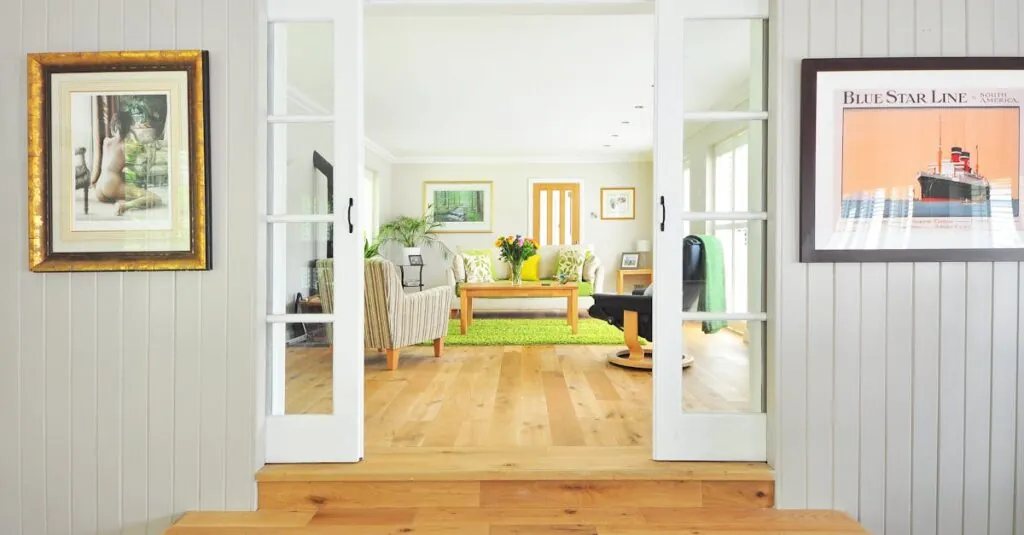Imagine a living room that’s not just a space but a statement. A minimalist living room without a sofa might sound like a design dare, but it’s the ultimate way to break free from clutter and embrace simplicity. Who needs a giant couch hogging all that precious space when you can have a chic floor setup that invites creativity and conversation?
Table of Contents
ToggleUnderstanding Minimalist Living Room Without Sofa
Minimalist living rooms without sofas create an inviting atmosphere through simplicity. This approach encourages a more flexible layout that promotes movement and interaction. Emphasis on open floor space allows for a variety of seating options, such as floor cushions or bean bags that adapt to individual needs.
A lack of traditional sofas reduces visual clutter, transforming the room into a tranquil environment. Natural elements play a crucial role. Adding plants introduces a sense of calm while improving air quality. Decorative items remain limited, highlighting essential pieces that serve both functional and aesthetic purposes.
Effective use of color enhances the minimalist theme. Neutral tones establish a serene backdrop, while pops of color from artwork or accessories can provide visual interest. Lighting also plays a significant role. Layering different types of lighting, such as ambient and task lighting, increases warmth and comfort.
Storage solutions become vital in this design. Multi-functional furniture, such as ottomans with hidden storage, keeps the space organized. Wall-mounted shelves display books or decorative objects without consuming floor space.
Furniture arrangements allow for conversation zones, effectively replacing the need for a sofa. Floor seating integrates seamlessly into the design while providing a relaxed setting. Additionally, an area rug can define the space, creating a cozy gathering spot.
Incorporating textures adds depth to the minimalist living room. Combining materials like wood, metal, and fabric offers visual harmony. Such approaches create a balanced aesthetic that embodies the essence of minimalist living without sacrificing comfort.
Key Principles of Minimalism
Minimalism centers around functionality, simplicity, and intentional design. Prioritizing these principles transforms a living room into a serene, stylish space without traditional furniture.
Functionality Over Aesthetics
Functionality reigns supreme in minimalist design. Each element must serve a purpose, ensuring the space remains efficient and inviting. Flexible seating options, like floor cushions or poufs, accommodate various activities. Improved space organization allows for versatile arrangements, inviting effortless movement and interaction. Serving trays and multifunctional tables enhance usability while maintaining a streamlined look. Minimal decor, including only essential artwork or a few plants, prevents distraction while supporting functionality.
Decluttering and Simplification
Decluttering is vital for minimalist living rooms. Removing excess items creates open spaces that feel airy and calm. Shedding unnecessary decor encourages mindful choices about belongings. Simplifying furniture arrangements further supports a spacious environment, emphasizing clear pathways and defined zones. Prioritizing storage solutions, such as stylish baskets or wall-mounted shelves, keeps belongings organized without visual clutter. This approach fosters a harmonious atmosphere, ultimately leading to a more balanced and peaceful lifestyle.
Furniture Alternatives for a Sofa-Free Space
A minimalist living room without a sofa opens up various options for creating a functional and inviting space. Consider these alternatives to enhance the atmosphere.
Modular Seating Options
Modular seating provides flexibility and adaptability. Arranging separate pieces allows for customized layouts that suit any occasion. Many modular units feature lightweight designs, enabling easy reconfiguration based on the needs of the moment. They promote interaction among guests, encouraging a fluid flow in the space. Options include ottomans and benches, offering opportunities for varied seating styles. Some designs incorporate storage, combining functionality with aesthetic appeal.
Floor Cushions and Poufs
Floor cushions and poufs serve as versatile seating solutions. These items can be moved around easily, catering to gatherings or relaxation. Their softness provides comfort while maintaining minimalist aesthetics. Various colors and patterns enable personal expression, enhancing visual interest within the room. Additionally, they encourage informal seating arrangements, fostering conversation. When stacked, floor cushions save space, proving practical in smaller areas. Consider a mix of sizes and shapes for added texture and appeal.
Design Elements to Enhance Minimalism
Creating a minimalist living room without a sofa involves thoughtful design elements that enhance the space’s tranquility and functional beauty. Prioritizing specific aspects adds depth and character while maintaining simplicity.
Color Palette and Textures
Neutral color palettes establish a calming foundation. Soft whites, grays, and beiges promote serenity and allow for effortless flow throughout the room. Textures also play a crucial role; combining wood, metal, and fabric adds visual interest without overwhelming the senses. Soft textiles for floor cushions or wall hangings introduce warmth and comfort, enhancing the inviting atmosphere. Each texture contributes uniquely to the overall aesthetic, achieving balance while maintaining minimalism.
Lighting and Ambiance
Layered lighting transforms the ambiance, creating a welcoming environment. Utilizing ambient, task, and accent lighting diversifies illumination and enhances functionality. Natural light through large windows boosts mood and fosters a connection with the outdoors. Strategic placement of floor lamps or wall sconces enhances cozy corners, inviting relaxation. Consider warm-toned bulbs for a soothing glow, reinforcing the minimalist ethos while improving emotional comfort. Every lighting choice impacts the overall vibe, making the space feel more vibrant yet tranquil.
Tips for Creating a Cozy Atmosphere
Creating a cozy atmosphere in a minimalist living room without a sofa involves thoughtful design choices. Prioritizing comfort and warmth leads to an inviting space.
Personal Touches and Décor
Incorporating personal items enhances the room’s character. Unique art pieces and handcrafted items add personality while maintaining minimalism. Use a few meaningful objects, like family photos or travel souvenirs, to create connection. Ensure that each piece serves a purpose, avoiding clutter. Soft throw blankets and decorative pillows offer warmth and comfort without overwhelming the visual space. Choosing a cohesive color palette for all décor items unifies the overall look. Displaying a few curated books or magazines on low shelves invites a relaxed atmosphere.
Incorporating Nature and Greenery
Adding plants brings life into a minimalist living room. Greenery improves air quality and contributes to emotional well-being. Select a variety of indoor plants to create visual interest and texture. Low-maintenance options like succulents thrive well in various light conditions. Position plants at different heights to enhance depth in the room. Utilizing wall-mounted planters or hanging pots saves floor space while maximizing greenery. Natural wood planters further blend with minimalist aesthetics. Ensuring adequate sunlight fosters a vibrant, healthy atmosphere, making the space feel welcoming.
Embracing a minimalist living room without a sofa opens up a world of design possibilities. This approach not only enhances the space’s functionality but also fosters a serene and inviting atmosphere. By prioritizing flexible seating options and thoughtful decor, individuals can create a layout that encourages interaction and movement.
Incorporating natural elements and layered lighting further enriches the minimalist aesthetic, making the space feel warm and welcoming. With intentional design choices, it’s possible to achieve both simplicity and comfort, proving that a sofa isn’t necessary for a stylish and functional living area. Ultimately, this design philosophy promotes a balanced lifestyle, allowing for both relaxation and social engagement in an organized and visually appealing environment.









